Design and Analysis of Magnetic Coils for Optimizing the Coupling Coefficient in an Electric Vehicle Wireless Power Transfer System
Abstract
1. Introduction
2. Mathematical Model Analysis of SS WPT Systems
3. Magnetic Coil Configuration Analysis
3.1. Coil Configurations Design
3.2. Analysis and Simulation of Different Coil Configurations
4. Square Coil Design and Verification
4.1. Self and Mutual Inductance Calculation
4.2. Magnetic Square Coil Verification
4.3. The Influence of the Internal Parameters for the Square Coil on the Coupling Coefficient
4.3.1. The Influence of the Diameter
4.3.2. The Influence of the Number of Turns
4.3.3. The Influence of the Inner Side Length
4.3.4. The Influence of the Outer Side Length
5. Comparative Study of Square Coil with Ferrite Cores
6. Conclusions
Author Contributions
Funding
Acknowledgments
Conflicts of Interest
References
- Mi, C.C.; Buja, G.; Choi, S.Y.; Rim, C.T. Modern Advances in Wireless Power Transfer Systems for Roadway Powered Electric Vehicles. IEEE Trans. Ind. Electron. 2016, 63, 6533–6545. [Google Scholar] [CrossRef]
- Ghosh, A. Possibilities and Challenges for the Inclusion of the Electric Vehicle (EV) to Reduce the Carbon Footprint in the Transport Sector: A Review. Energies 2020, 13, 2602. [Google Scholar] [CrossRef]
- González Palencia, J.C.; Nguyen, V.T.; Araki, M.; Shiga, S. The Role of Powertrain Electrification in Achieving Deep Decarbonization in Road Freight Transport. Energies 2020, 13, 2459. [Google Scholar] [CrossRef]
- Xiaoli, S.; Zhengguo, L.; Xiaolin, W.; Chengjiang, L. Technology Development of Electric Vehicles: A Review. Energies 2020, 13, 90. [Google Scholar] [CrossRef]
- De Santis, M.; Agnelli, S.; Patanè, F.; Giannini, O.; Bella, G. Experimental Study for the Assessment of the Measurement Uncertainty Associated with Electric Powertrain Efficiency Using the Back-to-Back Direct Method. Energies 2018, 11, 3536. [Google Scholar] [CrossRef]
- Ehsani, M.; Falahi, M.; Lotfifard, S. Vehicle to Grid Services: Potential and Applications. Energies 2012, 5, 4076–4090. [Google Scholar] [CrossRef]
- Shekhar, A.; Prasanth, V.; Bauer, P.; Bolech, M. Generic Methodology for Driving Range Estimation of Electric Vehicle with on-Road Charging. In Proceedings of the 2015 IEEE Transportation Electrification Conference and Expo (ITEC), Dearborn, MI, USA, 14–17 June 2015; pp. 1–8. [Google Scholar]
- Maglaras, L.A.; Topalis, F.V.; Maglaras, A.L. Cooperative Approaches for Dynamic Wireless Charging of Electric Vehicles in a Smart City. In Proceedings of the 2014 IEEE International Energy Conference (Energycon 2014), Dubrovnik, Croatia, 13–16 May 2014; pp. 1365–1369. [Google Scholar]
- Wang, Y.J.; Hu, X.H.; Yao, Y.S.; Liu, X.S.; Xu, D.G.; Cai, L.; Hu, B.R.; Hua, K. A Dynamic Wireless Power Transfer System with Parallel Transmitters. In Proceedings of the 2017 IEEE Transportation Electrification Conference and Expo, Asia-Pacific (ITEC Asia-Pacific), Harbin, China, 2–10 August 2017; pp. 146–151. [Google Scholar]
- Yang, L.; Zhang, B.; Ju, M. A Fast Dynamic Response Regulation Method for Undersea Wireless Power Transfer System. In Proceedings of the 2019 14th IEEE Conference on Industrial Electronics and Applications (ICIEA), Xi’an, China, 19–21 June 2019; pp. 1162–1166. [Google Scholar]
- Suh, I.S.; Kim, J. Electric Vehicle On-Road Dynamic Charging System with Wireless Power Transfer Technology. In Proceedings of the IEEE International Electric Machines and Drives Conference (IEMDC), Chicago, IL, USA, 12–15 May 2013; pp. 234–240. [Google Scholar]
- Debbou, M.; Colet, F. Inductive Wireless Power Transfer for Electric Vehicle Dynamic Charging. In Proceedings of the IEEE PELS Workshop on Emerging Technologies—Wireless Power (WoW), Knoxville, TN, USA, 4–6 October 2016; pp. 118–122. [Google Scholar]
- Niculae, D.; Iordache, M.; Stanculescu, M.; Bobaru, M.L.; Deleanu, S. A Review of Electric Vehicles Charging Technologies Stationary and Dynamic. In Proceedings of the 11th International Symposium on Advanced Topics in Electrical Engineering (ATEE), Bucharest, Romania, 28–30 March 2019; p. 4. [Google Scholar]
- Kim, M.; Kim, K.A.; Kim, J.; Jung, J.H. Design Methodology of a 500 W Wireless Power Transfer Converter. In Proceedings of the 2015 IEEE PELS Workshop on Emerging Technologies Wireless Power (WoW), KAIST, Daejeon, Korea, 5–6 June 2015; p. 6. [Google Scholar]
- Kalwar, K.A.; Mekhilef, S.; Seyedmahmoudian, M.; Horan, B. Coil Design for High Misalignment Tolerant Inductive Power Transfer System for EV Charging. Energies 2016, 9, 937. [Google Scholar] [CrossRef]
- Villa, J.L.; Sallan, J.; Osorio, J.F.S.; Llombart, A. High-Misalignment Tolerant Compensation Topology for ICPT Systems. IEEE Trans. Ind. Electron. 2012, 59, 945–951. [Google Scholar] [CrossRef]
- Budhia, M.; Covic, G.A.; Boys, J.T. Design and Optimization of Circular Magnetic Structures for Lumped Inductive Power Transfer Systems. IEEE Trans. Ind. Electron. 2011, 26, 3096–3108. [Google Scholar] [CrossRef]
- Knaisch, K.; Gratzfeld, P. Comparison of Magnetic Couplers for Inductive Electric Vehicle Charging Using Accurate Numerical Simulation and Statistical Methods. In Proceedings of the 2015 5th International Electric Drives Production Conference (EDPC), Nuremberg, Germany, 15–16 September 2015; p. 10. [Google Scholar]
- Prasanth, V.; Bandyopadhyay, S.; Bauer, P.; Ferreira, J.A. Analysis and Comparison of Multi-Coil Inductive Power Transfer Systems. In Proceedings of the 2016 IEEE International Power Electronics and Motion Control Conference (PEMC), Varna, Bulgaria, 25–28 September 2016; pp. 993–999. [Google Scholar]
- Anonymous. Comparative Study on Optimal Core Design for Maximizing the Coupling Coefficient in Electric Vehicle Inductive Power Transfer System. In Proceedings of the International Conference and Exhibition for Power Electronics, Intelligent Motion, Renewable Energy and Energy Management, Nuremberg, Germany, 14–16 May 2013; pp. 1525–1530. [Google Scholar]
- Budhia, M.; Boys, J.T.; Covic, G.A.; Huang, C.Y. Development of a Single-Sided Flux Magnetic Coupler for Electric Vehicle IPT Charging Systems. IEEE Trans. Ind. Electron. 2013, 60, 318–328. [Google Scholar] [CrossRef]
- Budhia, M.; Covic, G.A.; Boys, J.T.; Huang, C.Y. Development and evaluation of single sided flux couplers for contactless electric vehicle charging. In Proceedings of the IEEE Energy Conversion Congress and Exposition (ECCE), Phoenix, AZ, USA, 17–22 September 2011; pp. 614–621. [Google Scholar]
- Nagendra, G.R.; Covic, G.A.; Boys, J.T. Determining the physical size of inductive couplers for IPT EV systems. IEEE J. Emerg. Sel. Top. Power Electron. 2014, 2, 571–583. [Google Scholar] [CrossRef]
- Bosshard, R.; Kolar, J.W.; Muhlethaler, J.; Stevanovic, I.; Wunsch, B.; Canales, F. Modeling and eta-alpha-Pareto Optimization of Inductive Power Transfer Coils for Electric Vehicles. IEEE J. Emerg. Sel. Top. Power Electron. 2015, 3, 50–64. [Google Scholar] [CrossRef]
- Deng, J.J.; Li, W.H.; Nguyen, T.D.; Li, S.Q.; Mi, C.C. Compact and Efficient Bipolar Coupler for Wireless Power Chargers: Design and Analysis. IEEE Trans. Power Electron. 2015, 30, 6130–6140. [Google Scholar] [CrossRef]
- Triviño-Cabrera, A.; González-González, J.M.; Aguado, J.A. Wireless Power Transfer for Electric Vehicles: Foundations and Design Approach; Available online: https://doi.org/10.1007/978-3-030-26706-3 (accessed on 8 June 2020).
- Wenzhou, L.; Jinfei, S.; Chuliang, F. Study of magnetically-coupled resonant wireless power transfer electric car charging system. Electr. Mach. Control. 2016, 20, 46–53. [Google Scholar]
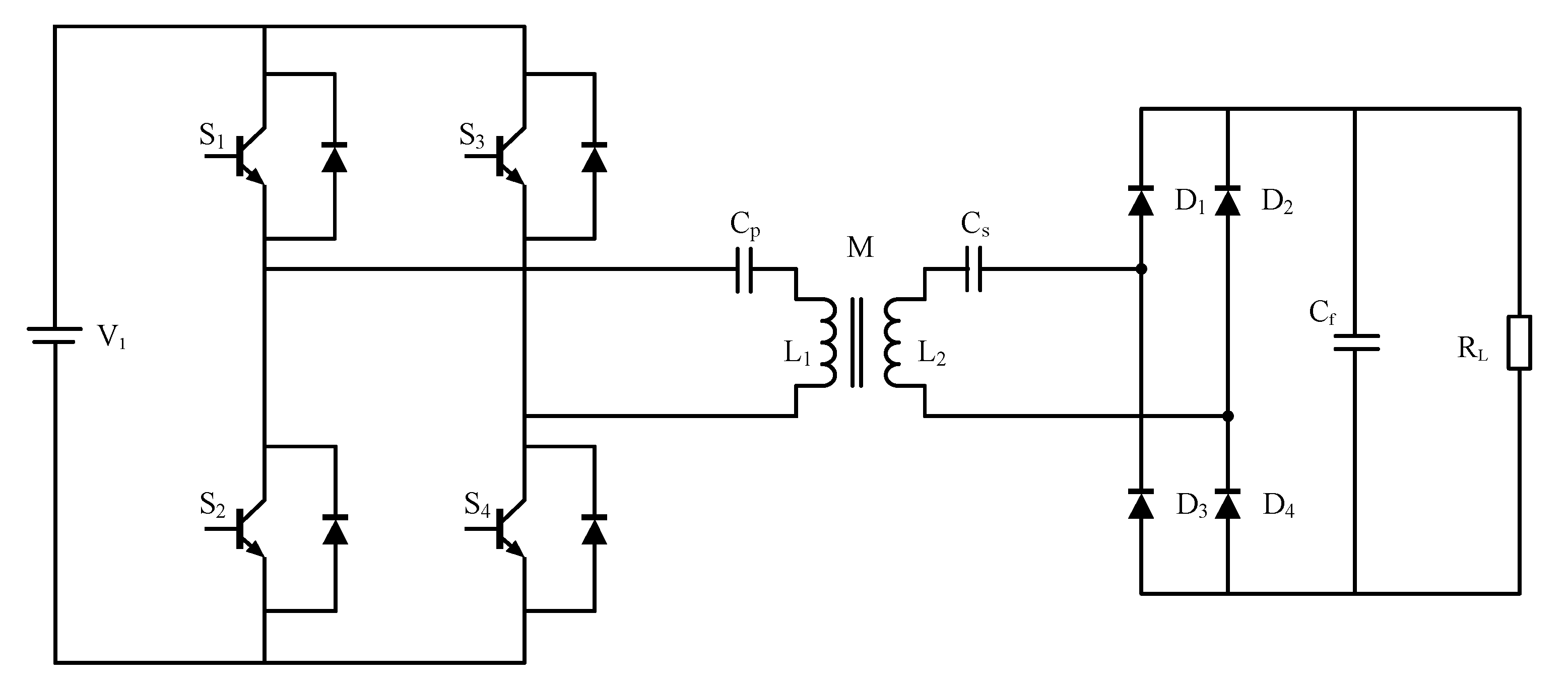
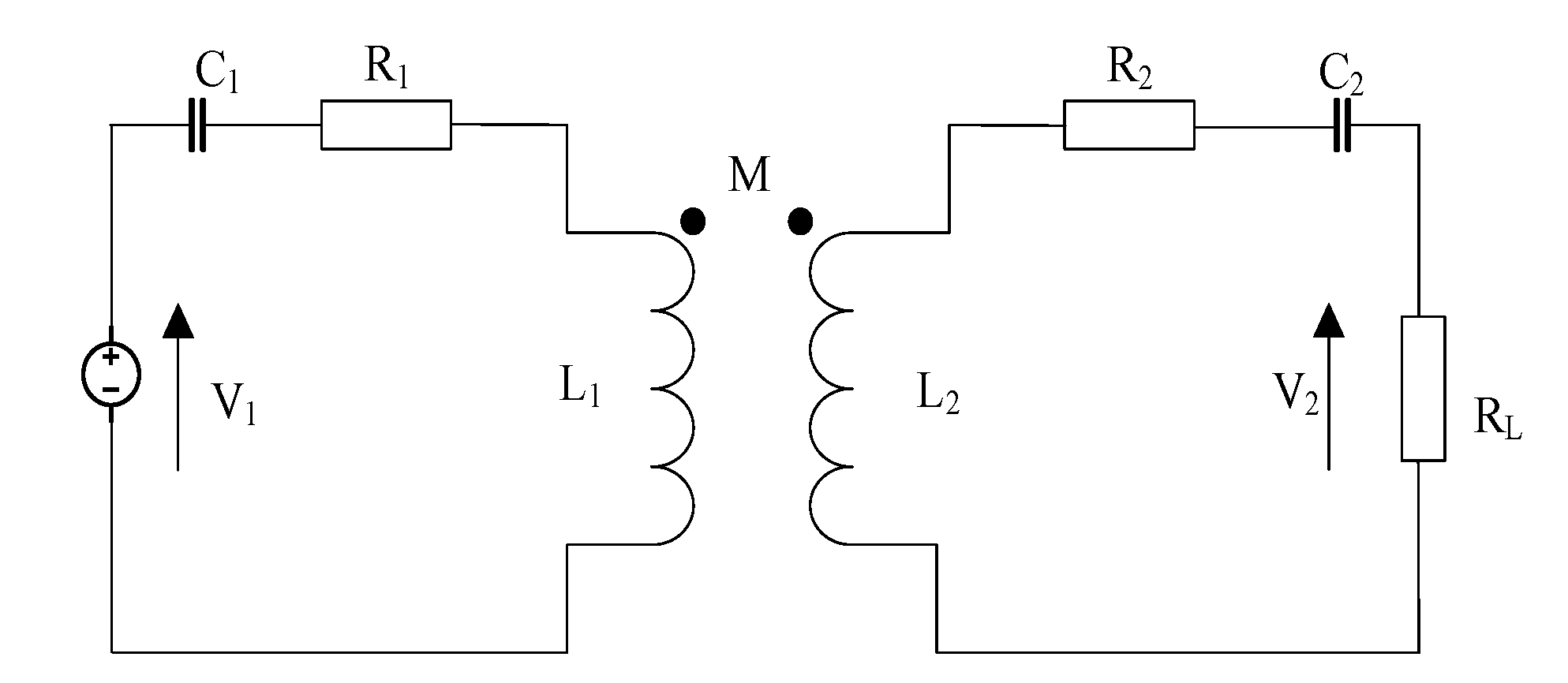
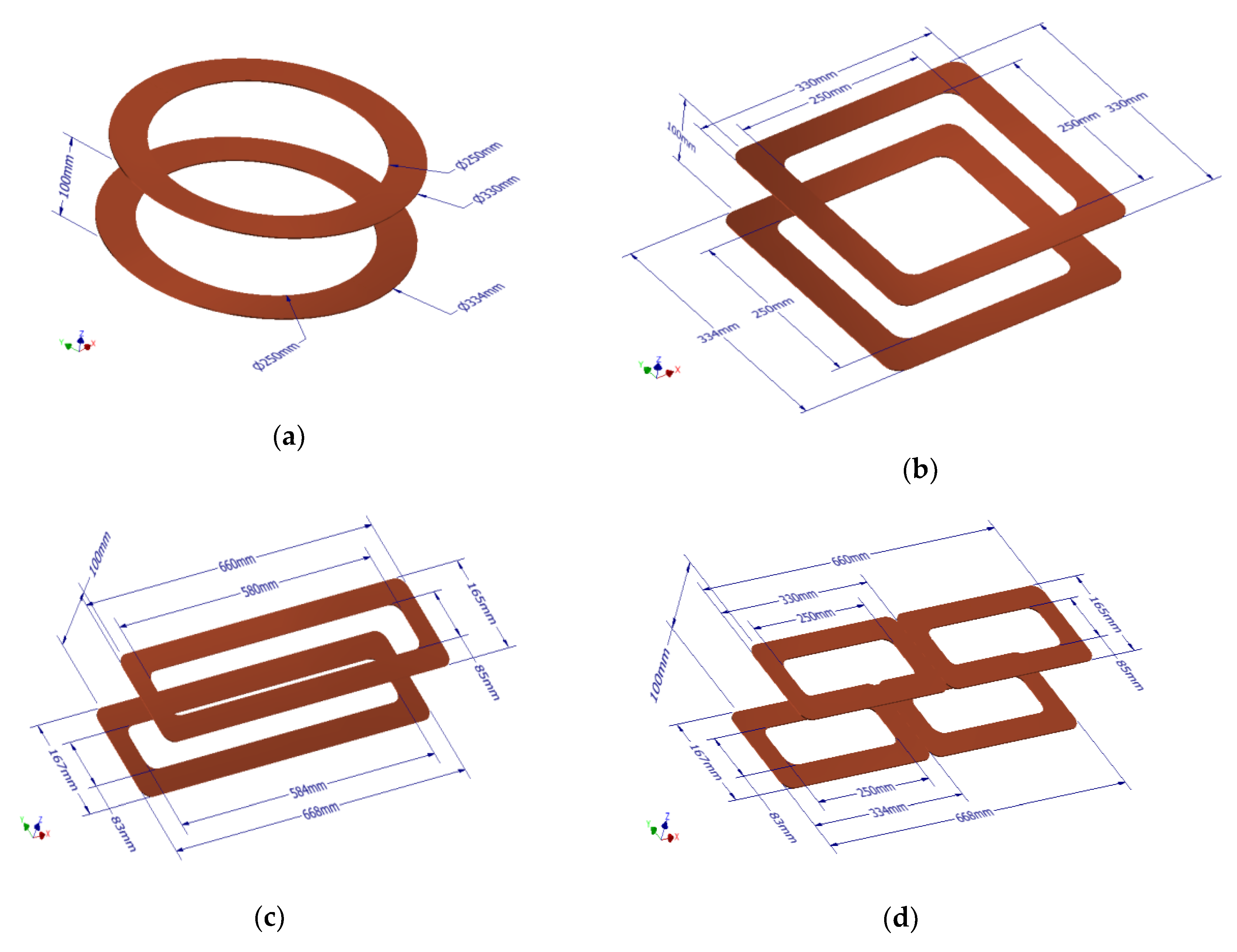
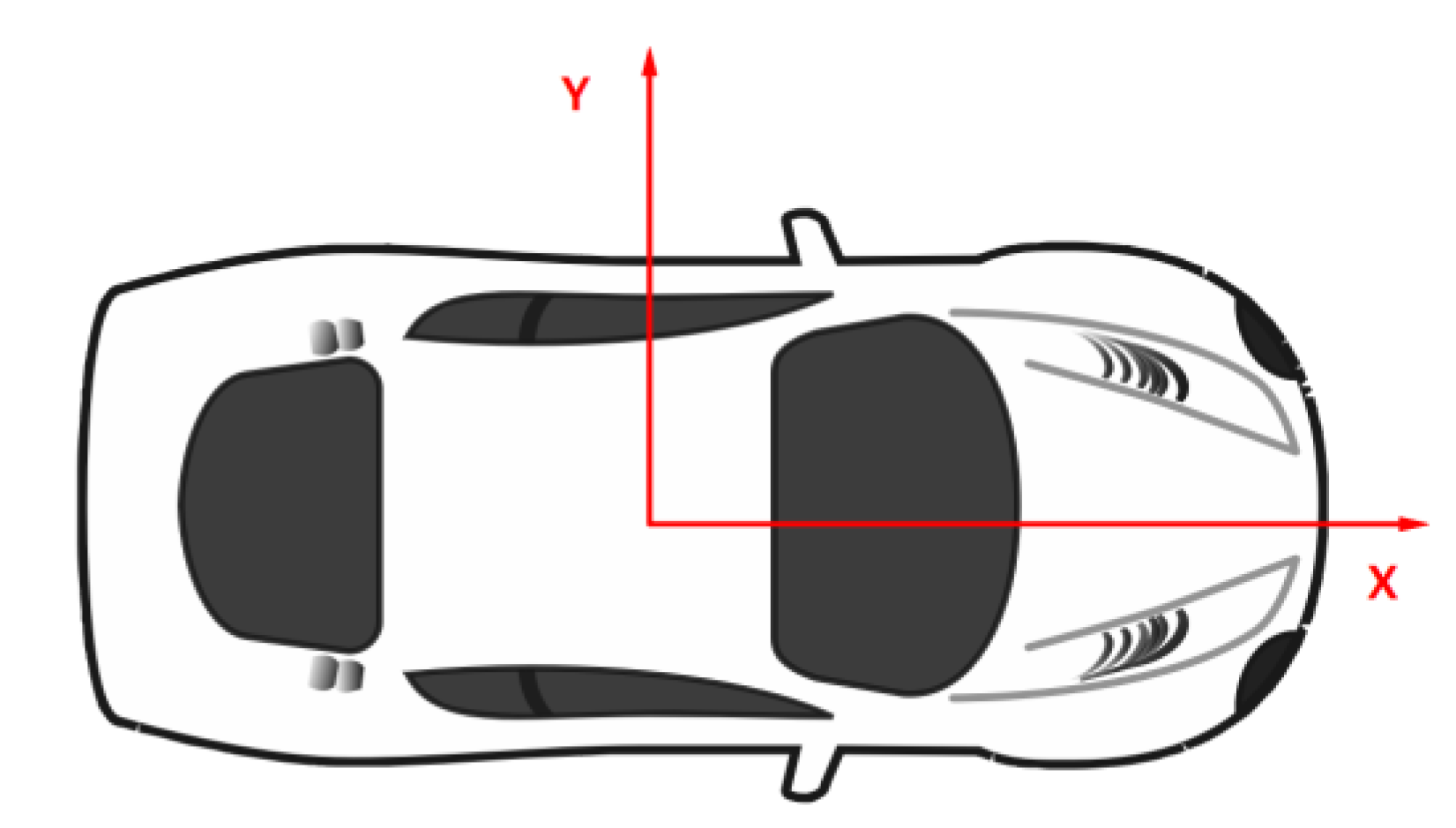
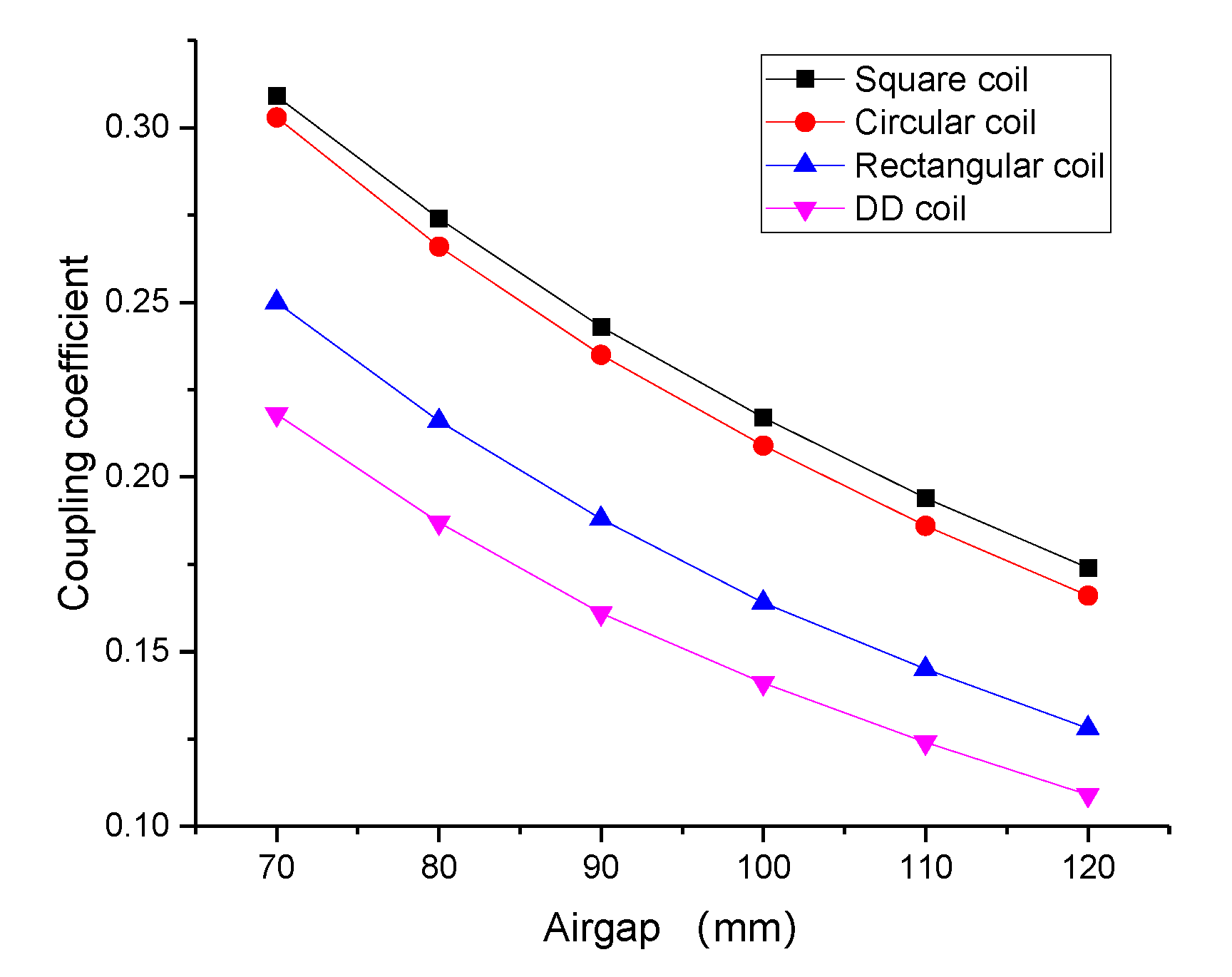
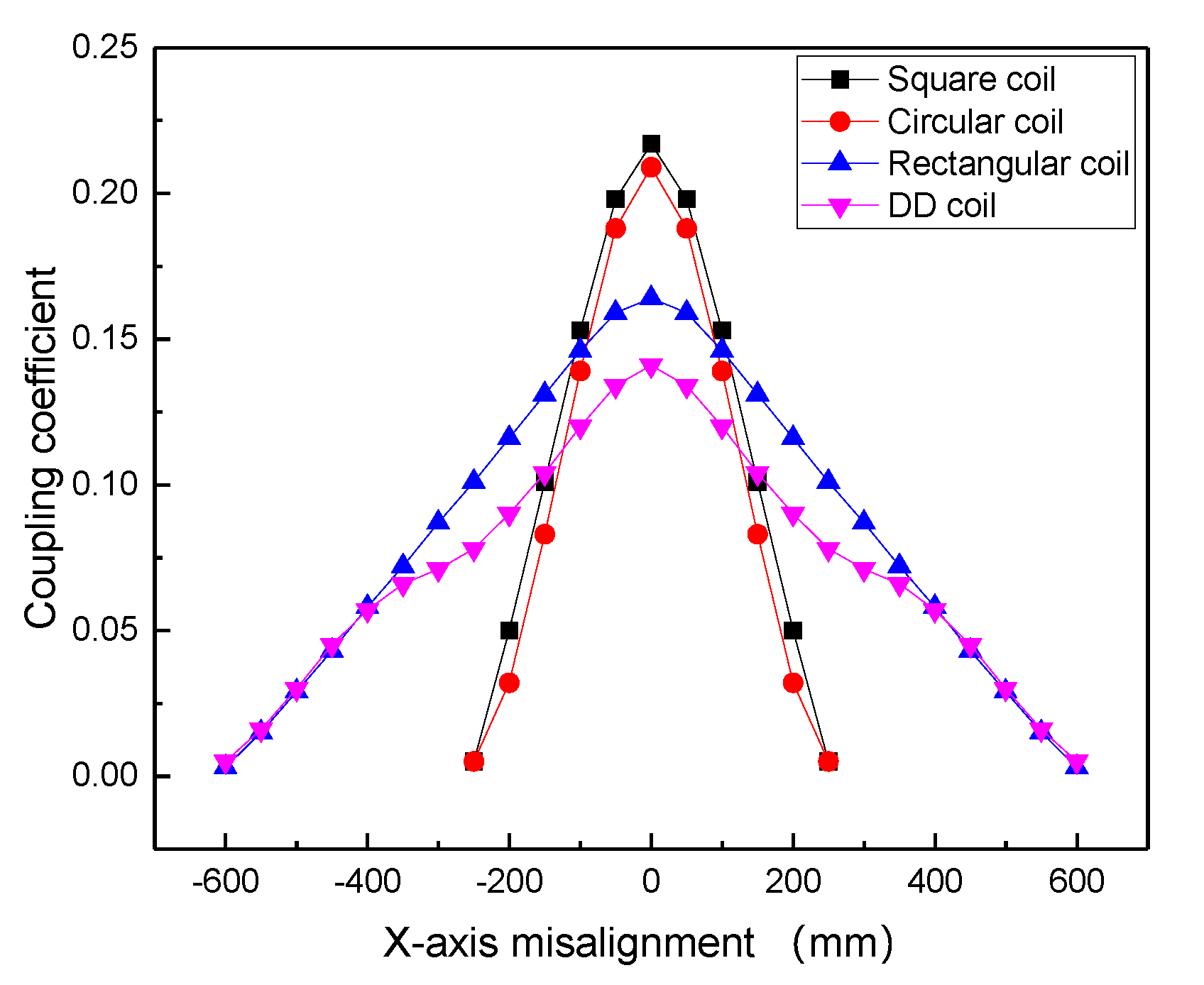

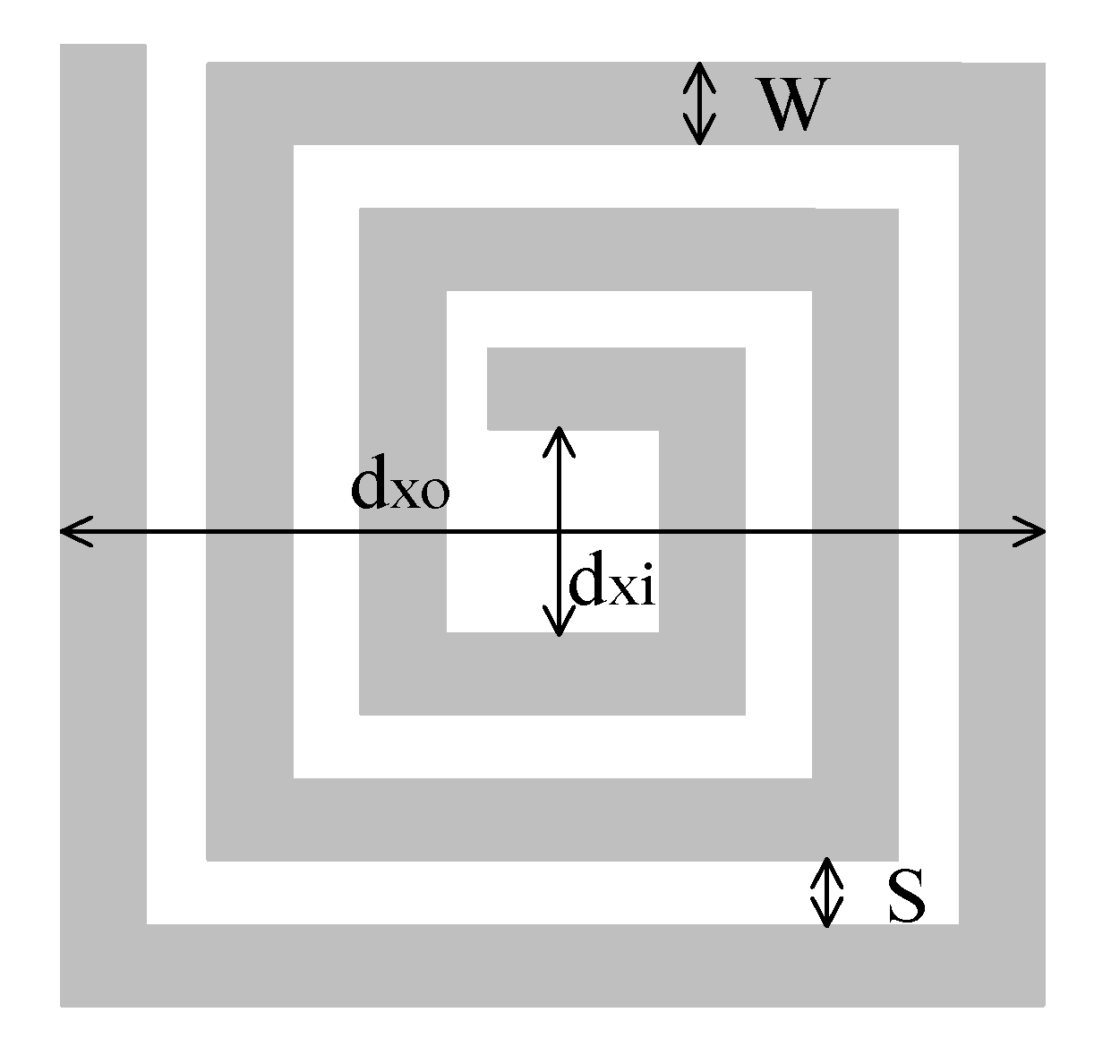

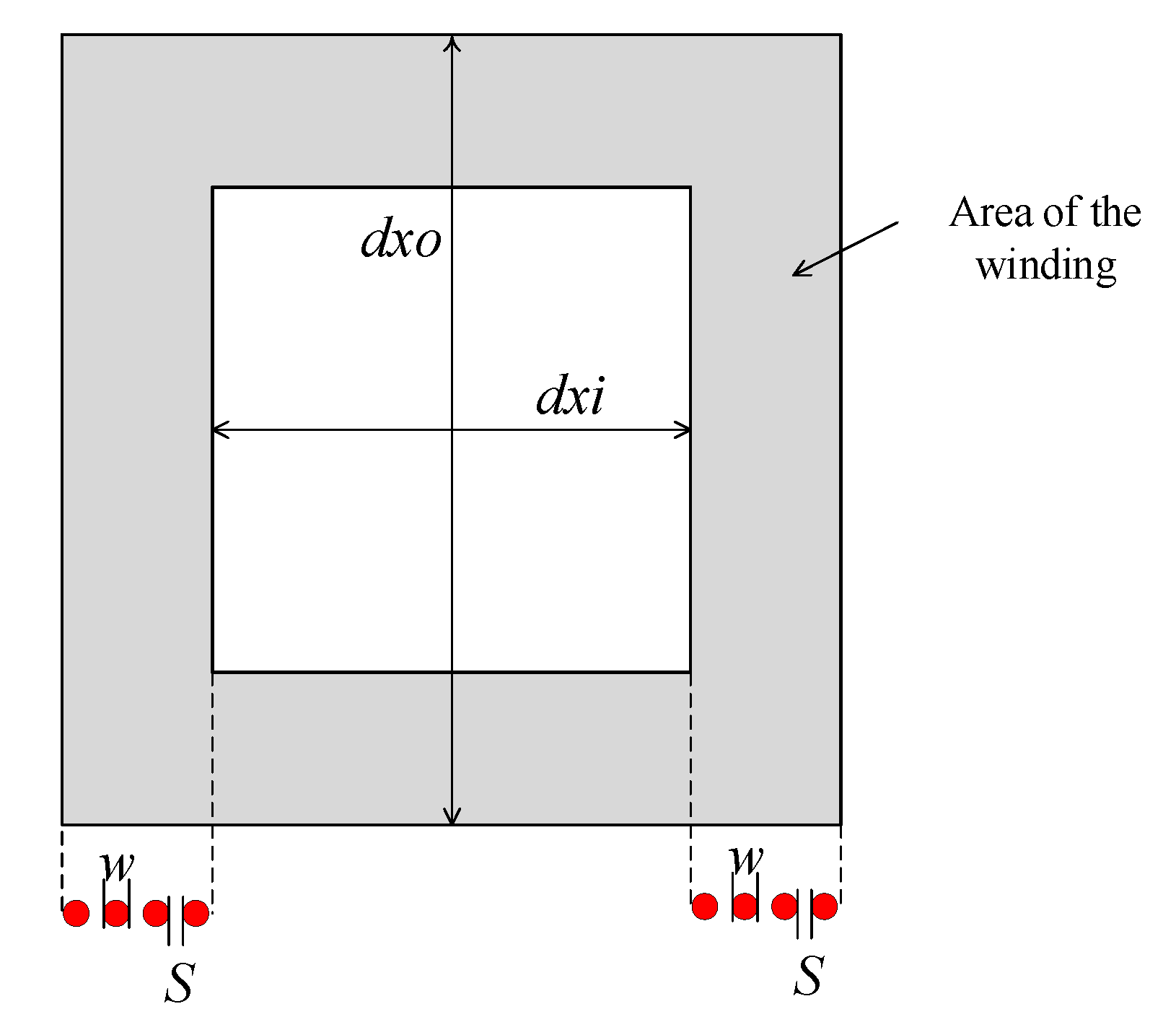
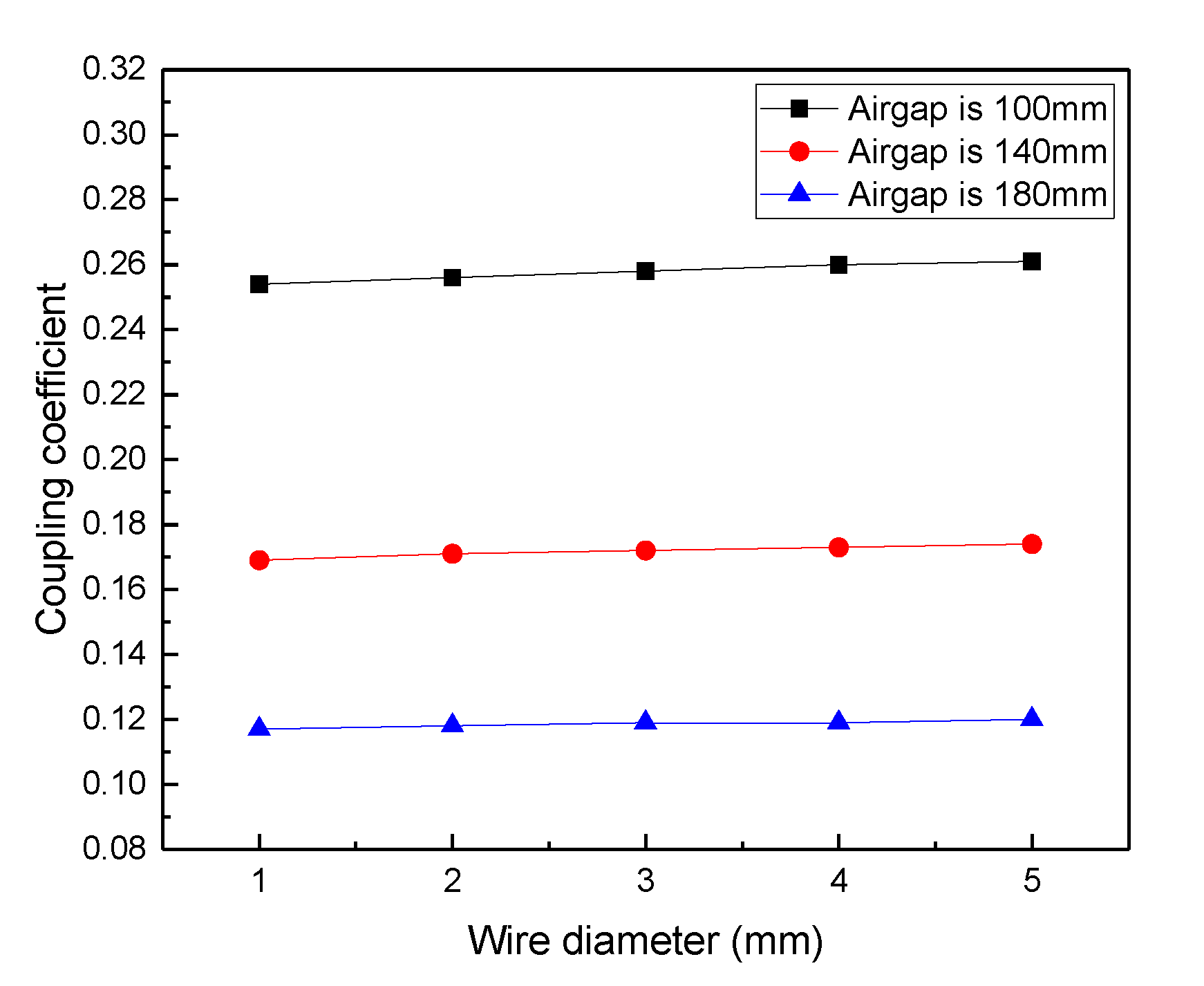

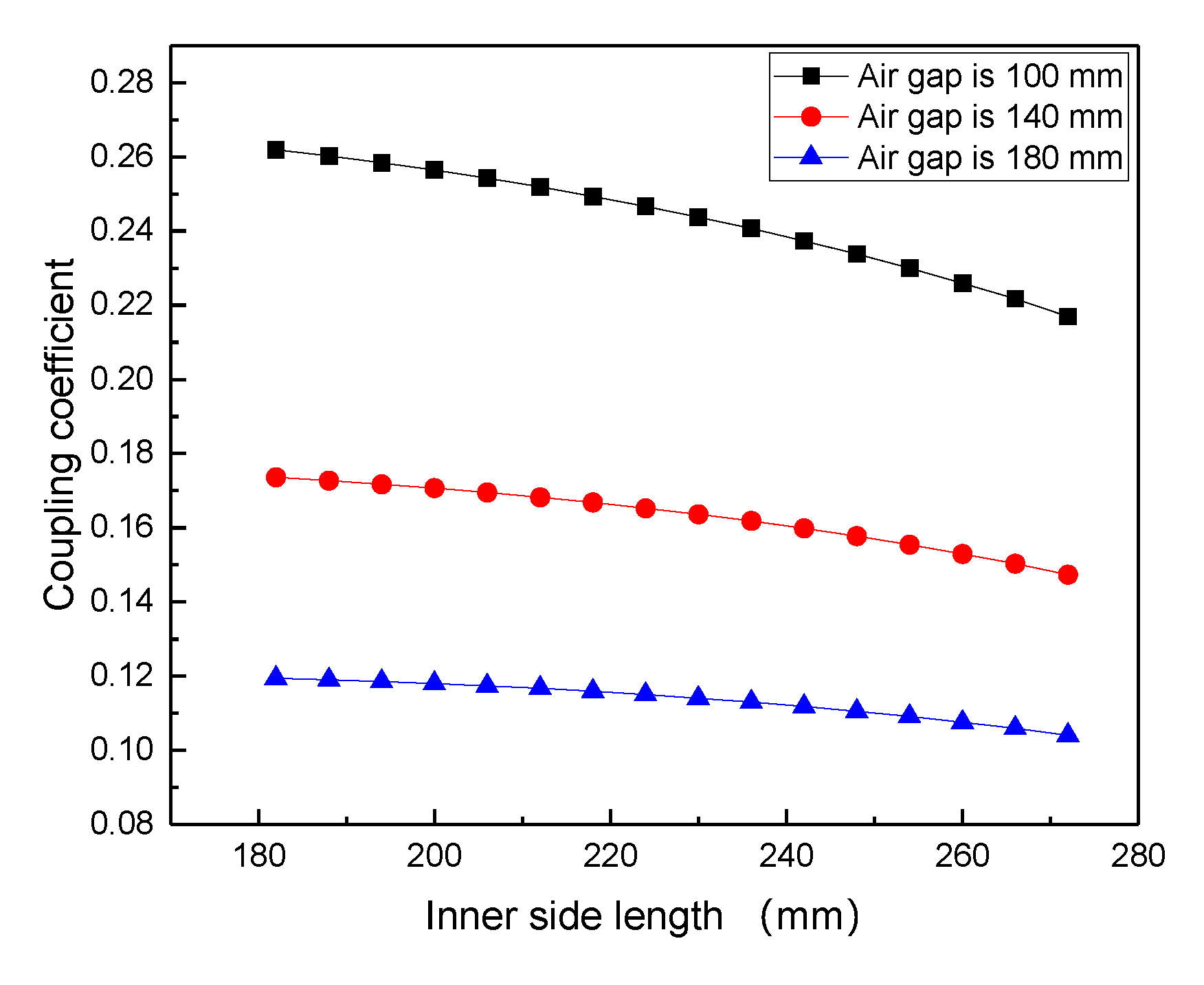
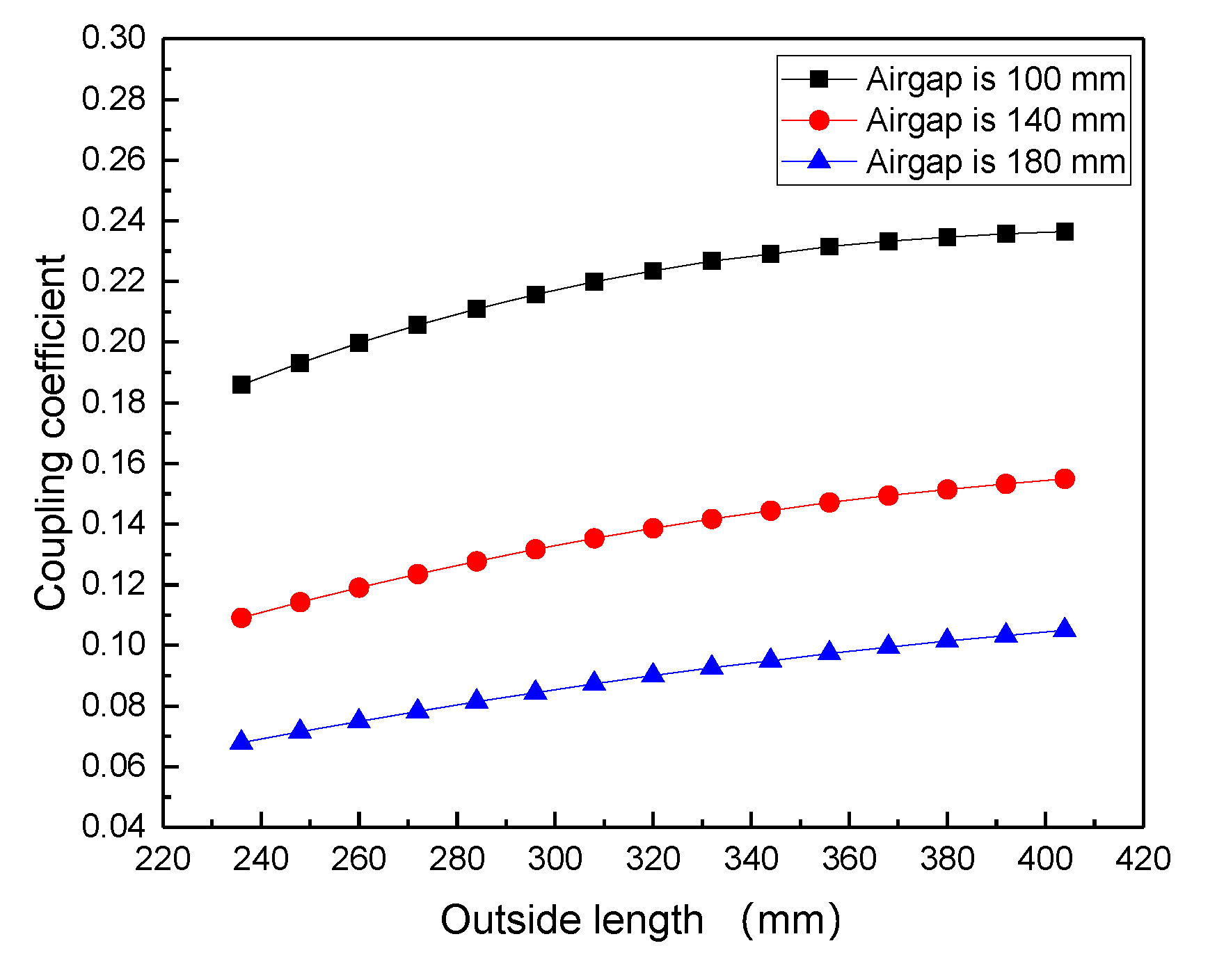

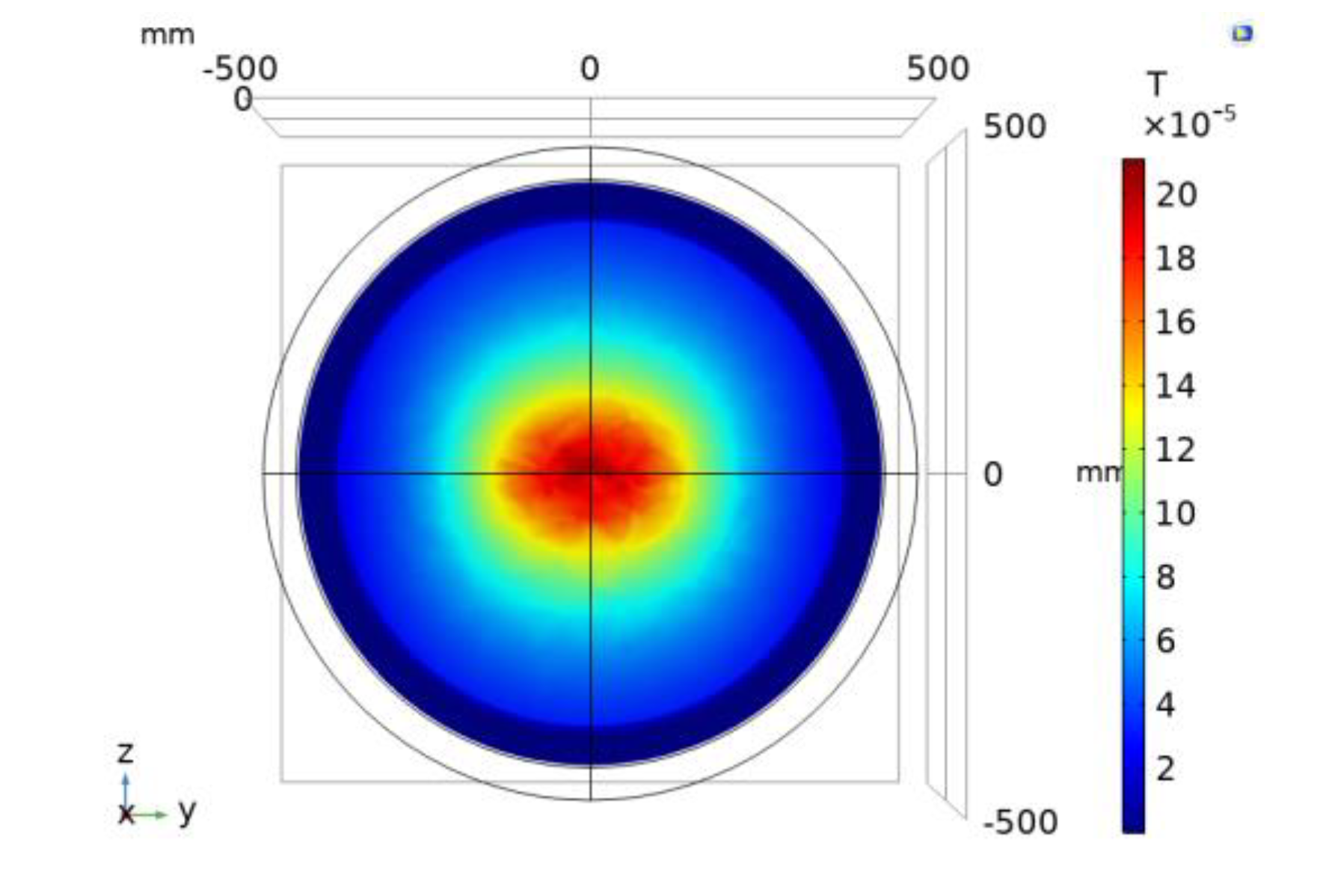
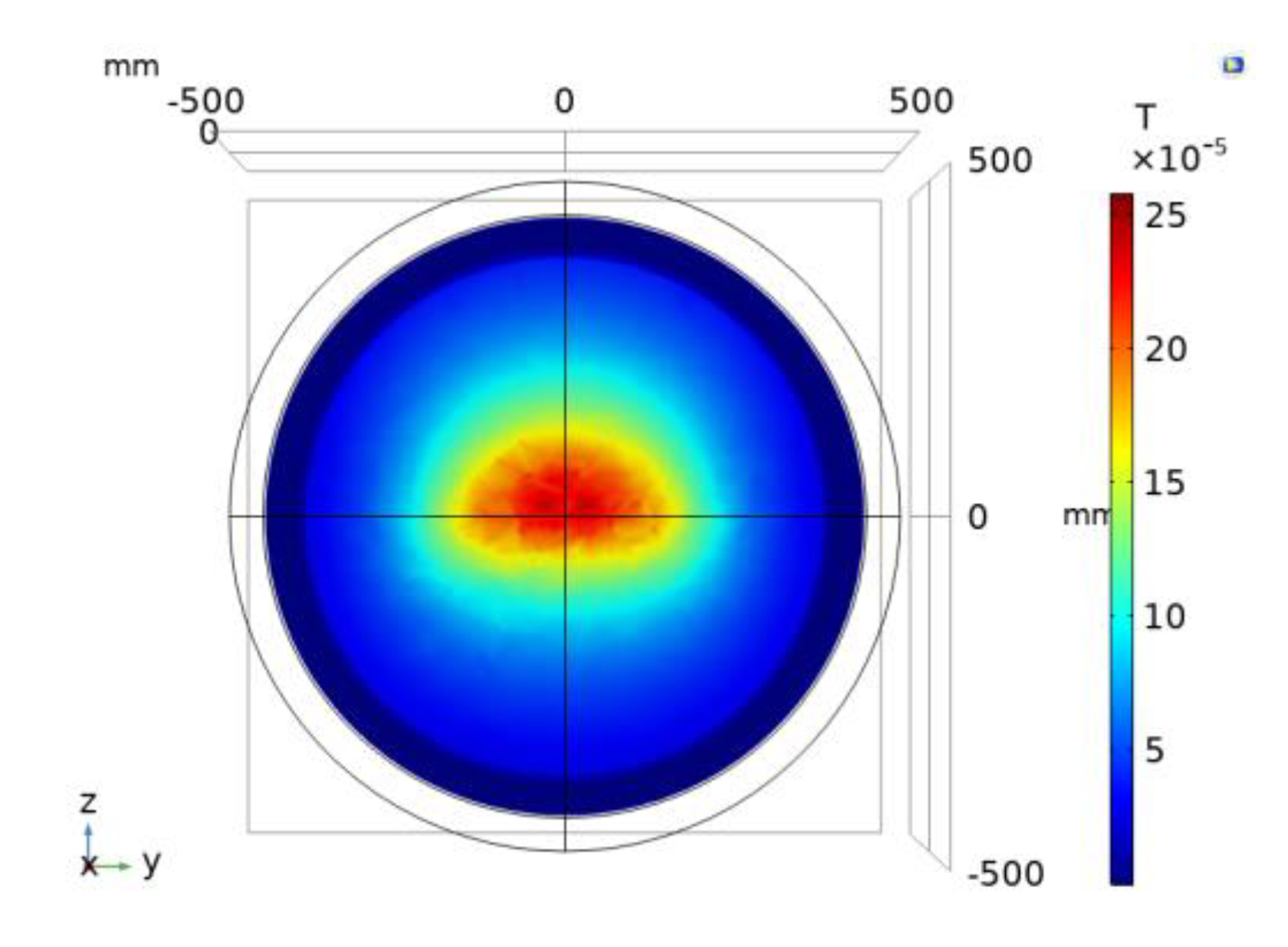

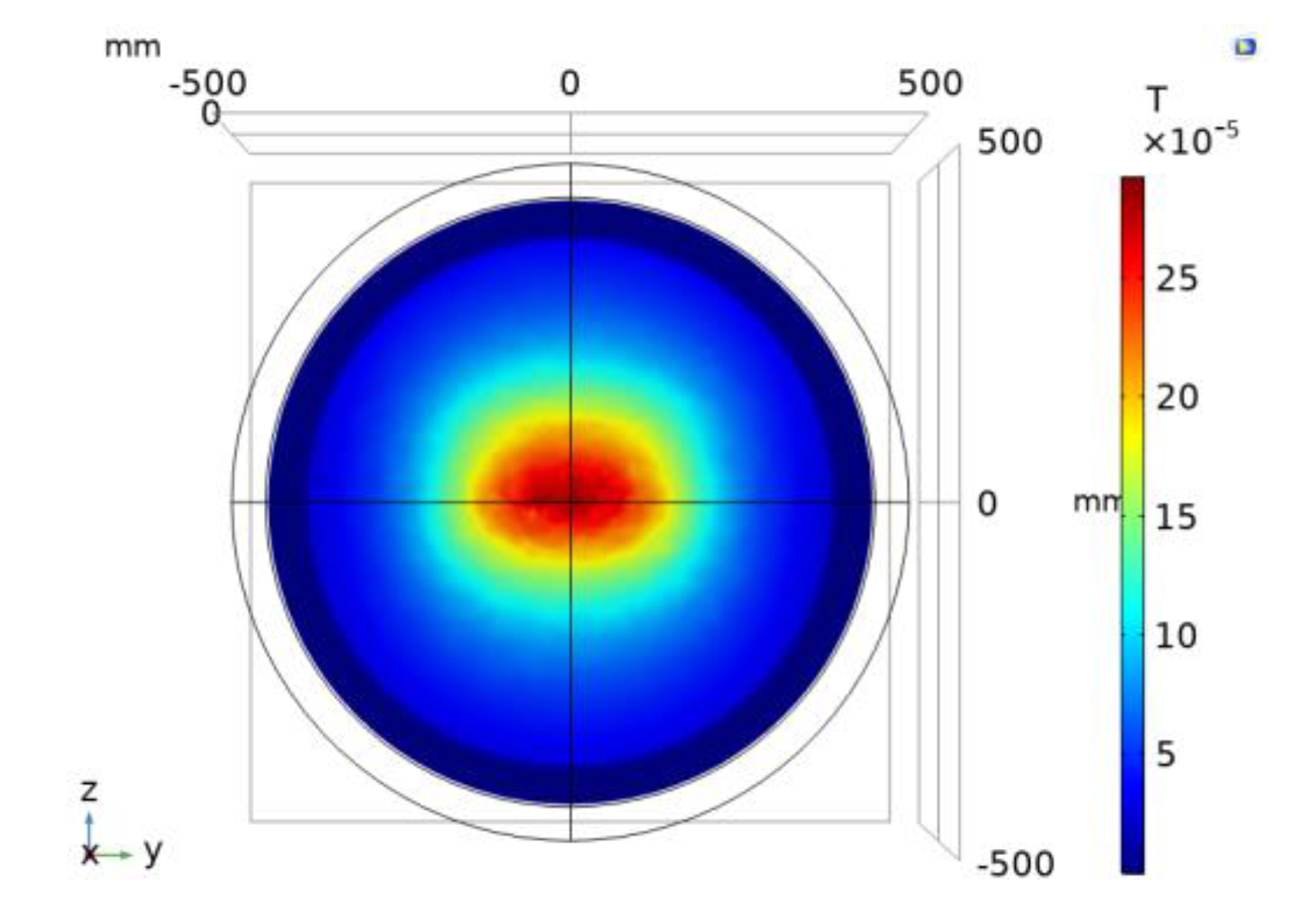
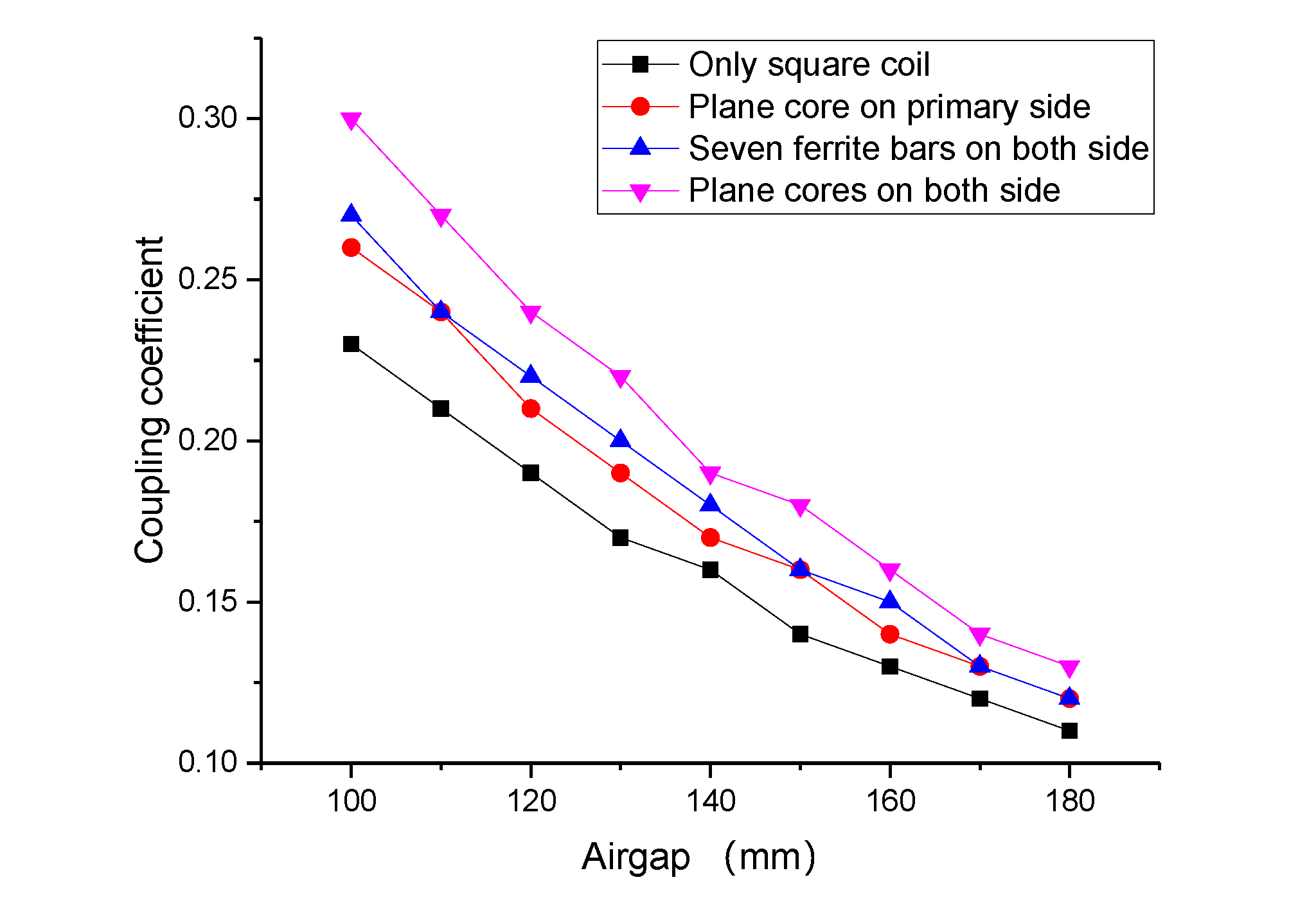
| Symbol | Quantity | Value |
|---|---|---|
| internal side length | 250 mm | |
| outer side length | 330 mm | |
| Np | primary coil number of turns | 22 |
| Ns | secondary coil number of turns | 22 |
| S | wire cross-sectional area | 2.6 mm2 |
| Symbol | Analytical Model | FEM | Error (%) |
|---|---|---|---|
| L (uH) | 302.24 | 295.91 | 2.1 |
| M (uH) | 70.63 | 69.02 | 2.3 |
| k | 0.2336 | 0.2332 | 0.17 |
| Symbol | Quantity | Value |
|---|---|---|
| internal side length | 250 mm | |
| outer side length | 330 mm | |
| Np | primary coil number | 22 |
| Ns | secondary coil number | 22 |
| S | wire cross-sectional area | 2.6 mm2 |
| at × bt × ht | ferrite bar size | 340 mm × 20 mm × 7 mm |
| a × b × h | plane core size | 340 mm × 340 mm × 7 mm |
© 2020 by the authors. Licensee MDPI, Basel, Switzerland. This article is an open access article distributed under the terms and conditions of the Creative Commons Attribution (CC BY) license (http://creativecommons.org/licenses/by/4.0/).
Share and Cite
Yang, Y.; Cui, J.; Cui, X. Design and Analysis of Magnetic Coils for Optimizing the Coupling Coefficient in an Electric Vehicle Wireless Power Transfer System. Energies 2020, 13, 4143. https://doi.org/10.3390/en13164143
Yang Y, Cui J, Cui X. Design and Analysis of Magnetic Coils for Optimizing the Coupling Coefficient in an Electric Vehicle Wireless Power Transfer System. Energies. 2020; 13(16):4143. https://doi.org/10.3390/en13164143
Chicago/Turabian StyleYang, Yang, Jinlong Cui, and Xin Cui. 2020. "Design and Analysis of Magnetic Coils for Optimizing the Coupling Coefficient in an Electric Vehicle Wireless Power Transfer System" Energies 13, no. 16: 4143. https://doi.org/10.3390/en13164143
APA StyleYang, Y., Cui, J., & Cui, X. (2020). Design and Analysis of Magnetic Coils for Optimizing the Coupling Coefficient in an Electric Vehicle Wireless Power Transfer System. Energies, 13(16), 4143. https://doi.org/10.3390/en13164143





